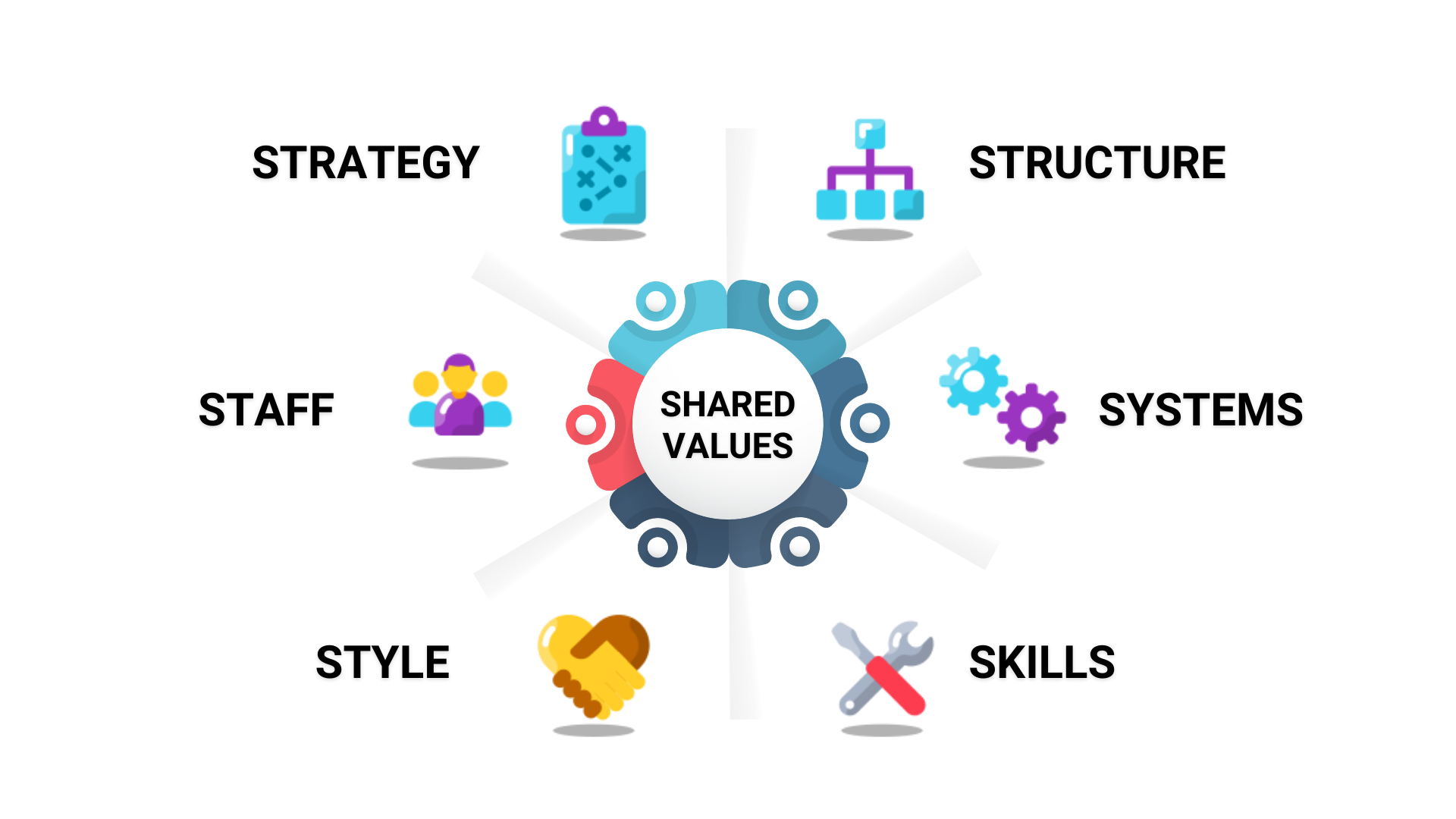In today’s dynamic and competitive business landscape, achieving sustainable growth is a paramount objective for entrepreneurs, key business leaders, and high-level organizational executives. To navigate this challenging terrain successfully, it’s essential to have a clear understanding of your organization’s internal dynamics and how they influence your ability to grow and scale effectively. This is where the McKinsey 7S Framework comes into play.
The McKinsey 7S Framework is a powerful management tool developed by the renowned consulting firm McKinsey & Company in the late 1970s. The Framework was originally introduced by consultants Robert H. Waterman Jr, Tom Peters, and Julien R. Phillips in their groundbreaking book “In Search of Excellence.” It was born out of a study that sought to uncover the common characteristics of excellent and successful companies. Over the years, the framework has evolved and adapted to the changing business landscape, making it a timeless tool for organizational assessment and strategic planning.
Understanding the McKinsey 7S Framework
The McKinsey 7S Framework consists of seven interrelated elements, each starting with the letter “S.” These elements are divided into two categories: hard elements and soft elements. Let’s take a closer look at each of these elements:

The McKinsey 7S Framework | Image by Author
Hard Elements (Tangible and Easier to Define):
- Strategy: This represents your organization’s roadmap for achieving its long-term objectives. It encompasses market positioning, resource allocation, and competitive advantage.
- Structure: Structure refers to your organization’s design and hierarchy, including reporting relationships and departmental divisions.
- Systems: Systems represent the processes, procedures, and workflows within your organization that support daily operations, including information systems and operational processes.
- Skills: Skills refer to the capabilities and competencies of your workforce, including their expertise, training, and skills relevant to their roles.
Soft Elements (Intangible and Harder to Define):
- Shared Values (or Superordinate Goals): Shared values are the core beliefs and guiding principles that shape your organization’s culture and influence decision-making.
- Style: Style relates to the leadership and management approach within your organization, including leadership behaviours, communication, and decision-making.
- Staff: Staff represents the people within your organization, their attitudes, motivation, and alignment with the organization’s culture and values.
Now, let’s explore how the McKinsey 7S Framework can serve as a catalyst for organizational and business growth:
- Alignment and Integration: The strength of the McKinsey 7S Framework lies in its emphasis on the alignment and integration of these seven elements. For growth to occur, all elements must work in harmony, supporting the overall strategy and vision.
- Diagnosing and Identifying Gaps: The framework serves as a diagnostic tool, allowing leaders to identify areas of misalignment or gaps that may hinder growth. For example, if your strategy calls for rapid expansion, but your organizational structure is rigid and bureaucratic, adjustments are needed.
- Strategic Planning: It guides strategic planning by helping leaders assess the readiness of the organization to execute a chosen strategy. It prompts questions like, “Do we have the necessary skills to implement this strategy?” or “Is our culture aligned with our strategic goals?”
- Change Management: When organizations seek to grow and scale, change is often required. The McKinsey 7S Framework helps in planning and managing change by considering how changes in one element may impact others. This holistic approach mitigates resistance to change.
- Cultural Transformation: Shared values and style are critical for fostering a growth-oriented culture. Leaders can use the framework to assess the current culture and implement strategies to cultivate a culture that embraces innovation, adaptability, and customer focus.
Leveraging the McKinsey 7S Framework for Growth
Let’s explore practical steps that entrepreneurs, key business leaders, and high-level organizational executives can take to leverage the McKinsey 7S Framework for growth:
1. Assess the Current State:
- Conduct a thorough assessment of your organization’s seven elements. Identify strengths, weaknesses, and areas of misalignment.
- Engage employees and stakeholders in this assessment to gain diverse perspectives.
2. Define Your Growth Strategy:
- Clearly articulate your growth objectives and strategy. Ensure it aligns with your organization’s values and culture.
- Consider how changes in strategy may impact structure, systems, and skills.
3. Align Leadership Style:
- Foster a leadership style that supports your growth strategy. Leaders should lead by example and communicate effectively.
- Encourage open and transparent communication channels.
4. Develop and Invest in Skills:
- Identify skills gaps and invest in training and development programs to enhance employee capabilities.
- Prioritize ongoing skill development to adapt to changing market conditions.
5. Build a Growth-Oriented Culture:
- Reinforce and communicate shared values that align with your growth goals.
- Recognize and reward behaviours that support growth and innovation.
6. Regularly Review and Adjust:
- Implement a continuous review process to ensure ongoing alignment and integration of the seven elements.
- Be prepared to adjust strategy, structure, or other elements in response to changing market dynamics.
7. Communicate and Engage:
- Communicate the importance of the McKinsey 7S Framework to all levels of the organization.
- Encourage employees to actively participate in the growth journey by sharing their insights and suggestions.
Global and African Case Studies
The 7S Framework has consistently proven its effectiveness in helping organizations and businesses align their internal elements for improved performance, adaptability, and growth. It also has a rich history of successful application across diverse global businesses, highlighting its enduring relevance. Some global and African case studies include;
- General Electric (GE): Was one of the earliest adopters of the McKinsey 7S Framework. In the 1980s, under the leadership of CEO Jack Welch, GE utilized the framework to transform its business into a global powerhouse. By aligning its strategy, structure, systems, and culture, GE became a prime example of how the framework can drive growth and profitability.
- IBM: As a global technology giant, IBM employed the McKinsey 7S Framework to navigate its transformation from a hardware-centric company to a services and solutions provider. The framework helped IBM realign its internal elements to adapt to the rapidly changing technology landscape and maintain its market leadership.
- Naspers: This global media and technology conglomerate based in South Africa, employed the McKinsey 7S Framework to realign its structure, systems, and staff with a digital-first strategy. This transformation allowed Naspers to transform from a traditional media company into a global tech investor, capitalizing on the growth of internet and e-commerce businesses, including its investments like the $32 million investment in China-based Tencent in 2001.
- Safaricom: Kenya’s leading telecommunications company, utilized the McKinsey 7S Framework to align its strategy, structure, and systems with its rapid expansion and diversification. The framework was used to align Safaricom’s strategy, particularly in terms of the introduction and expansion of M-Pesa, with the company’s structure and operational systems. This alignment allowed Safaricom to seize opportunities in Kenya’s evolving mobile banking and telecommunications market.
- Procter & Gamble (P&G): This multinational consumer goods corporation, has leveraged the framework to streamline its product portfolio and optimize its supply chain. By aligning its strategy, structure, systems, and staff, P&G has achieved impressive growth and market expansion.
- Standard Bank: As one of the largest financial institutions in South Africa, Standard Bank applied the McKinsey 7S Framework to enhance its internal capabilities and develop a clear strategy for expansion across African markets. The strategy focused on international expansion, risk management, and corporate governance which aided in harmonizing various aspects of its operations for cross-border success.
These Global and African businesses recognized the value of the McKinsey 7S Framework in driving growth, adaptability, and competitiveness in the African market. By aligning their internal elements, they were able to navigate the unique challenges and opportunities presented by the diverse Global and African business landscape.
The McKinsey 7S Framework is still relevant as a valuable tool that can drive organizational and business growth by providing a holistic view of the internal elements that shape an organization’s success. By recognizing the interdependencies among strategy, structure, systems, skills, shared values, style, and staff, Entrepreneurs, key business leaders, and high-level organizational executives can use this framework to diagnose alignment issues, plan for growth, manage change and cultivate a growth-oriented culture, positioning their organizations for sustainable growth in a dynamic and competitive business environment.
Embracing the McKinsey 7S Framework as a driver for growth is not just a strategy; it’s a commitment to excellence and the pursuit of organizational greatness.
I originally published this article on my personal blog.


